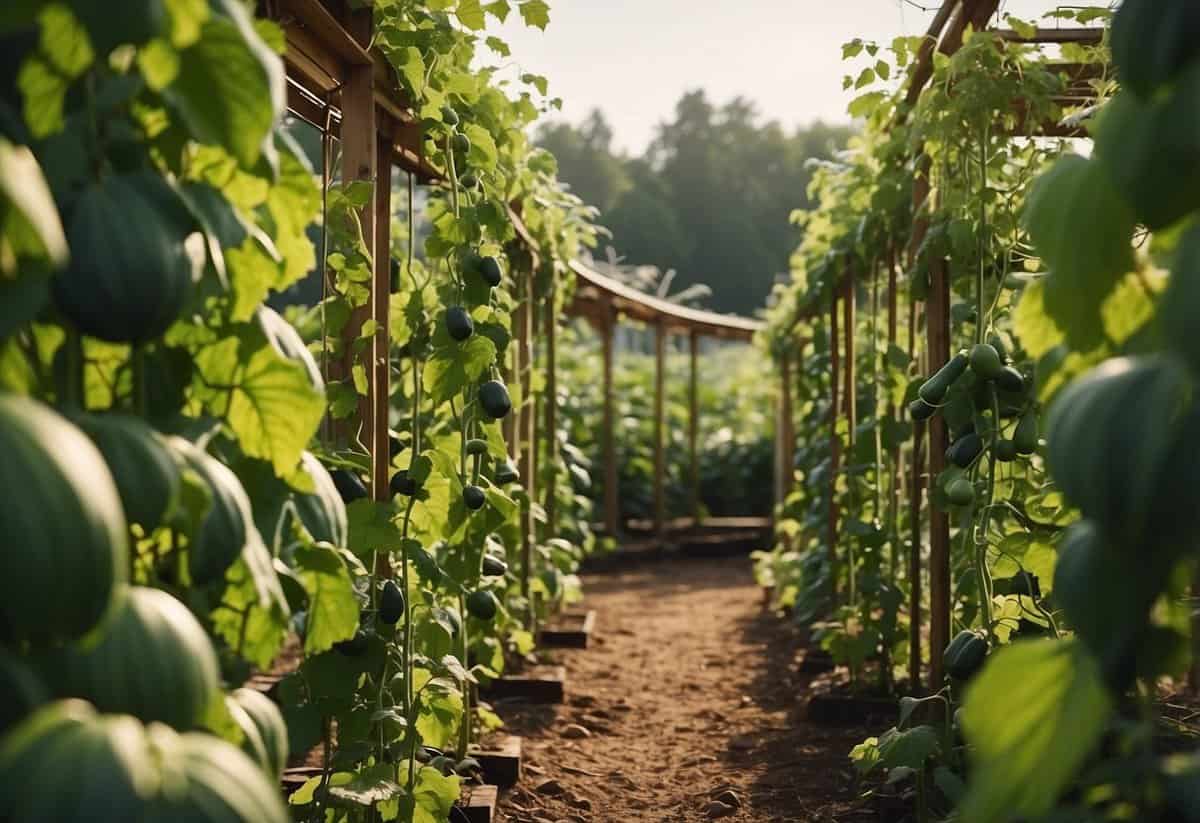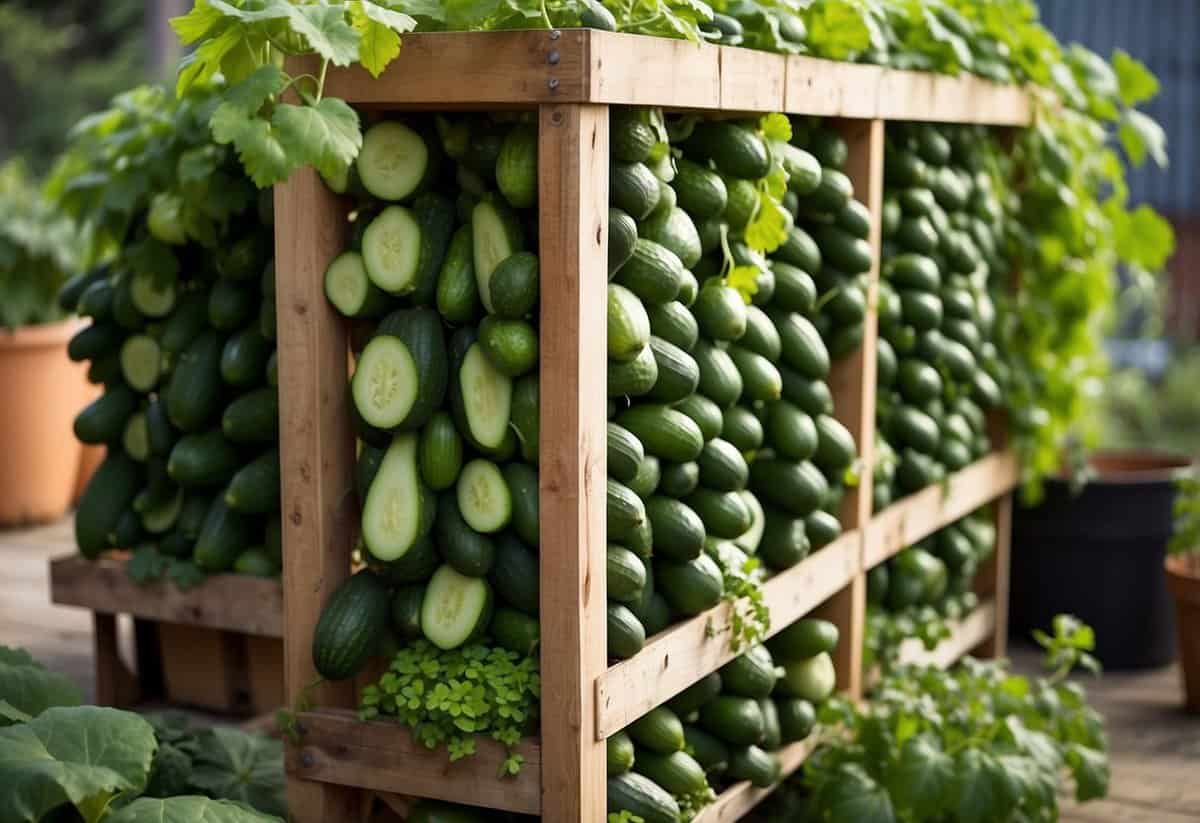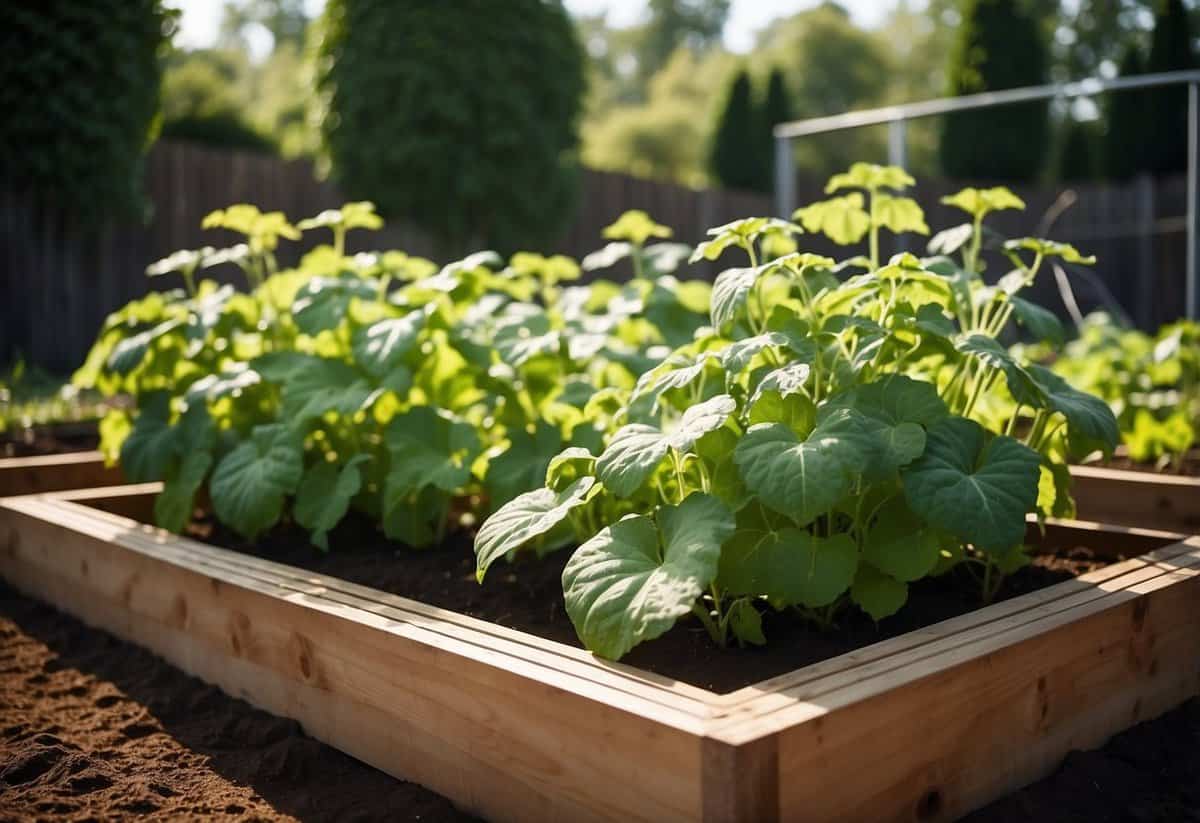Cucumber Garden Ideas: Creative Tips for a Bountiful Harvest
Growing cucumbers in your garden can be a fun and rewarding experience. There are many creative ways to set up your garden to help cucumbers thrive. The main goal is to find methods that fit your space and resources while maximizing your harvest.

When you think about cucumber garden ideas, consider both the aesthetic and practical aspects. Cucumbers need support to grow vertically, which not only saves space but also improves air circulation and makes harvesting easier. With the right approach, you’ll enjoy a healthy and productive cucumber garden.
1) Vertical Trellis Setup

A vertical trellis is perfect for your cucumber garden. You can make one using 2×3 boards and twine, which is very effective and affordable.
Plant cucumber seeds at the base of the trellis, spacing them about 4-5 inches apart. As your cucumbers grow, guide the vines to climb up using plant clips or ties.
For small spaces, this setup ensures that your cucumbers have plenty of room to thrive without crowding other plants. Check out these cucumber trellis ideas for more inspiration.
2) DIY Cucumber Arbor

A cucumber arbor can add both function and beauty to your garden. It’s a simple structure that supports cucumber vines as they grow.
To start, you need sturdy materials like wood or metal for the frame. Ensure that the arbor is tall enough for cucumber vines, which can reach up to 8 feet.
Install lattice panels on the sides of the arbor. This gives the cucumber vines something to grab onto as they climb. As the plants grow, they will create a lush, green canopy overhead.
Using a cucumber arbor not only saves space, but also makes harvesting easier, as cucumbers hang down and are easier to spot. For a detailed guide, you can check out a cucumber trellis tutorial.
3) Hanging Basket Cucumbers

Growing cucumbers in hanging baskets is a fantastic way to save ground space. They look great and are easy to care for.
Make sure your basket has drainage holes to let out excess water. Give your cucumbers 6-8 hours of sunlight each day
Choose varieties like Spacemaster or Bush Slicer. These are compact and perfect for limited spaces.
Keep the soil moist and check it daily. Water when it feels dry. With proper care, you’ll enjoy fresh cucumbers right from your hanging basket.
4) Pallet Planter Idea

Using a pallet for a cucumber garden is a great idea. Pallets are easy to find and usually don’t cost much. With a pallet, you can create a vertical garden that saves space.
Simply lean the pallet against a wall or fence. Secure it well so it doesn’t fall. You can grow cucumbers by planting them at the base of the pallet.
As the cucumbers grow, they will climb up the pallet. This keeps the cucumbers off the ground and makes them easier to pick. Using a pallet to grow cucumbers is both practical and fun!
For more details, visit Lovely Greens.
5) Cucumber Tunnel Archway

A cucumber tunnel archway is a fantastic addition to your garden.
You can easily build one using materials like sturdy metal fencing or wood.
Plant your cucumber seeds or seedlings on both sides of the arch, and watch as they grow and climb.
This setup not only looks appealing but also allows you to walk underneath and pick your cucumbers conveniently.
For more detailed instructions, check out how to build a cucumber trellis archway.
6) Container Gardening Tips

Cucumbers thrive in containers with the right care. Start with a high-quality potting mix. Garden soil is too heavy and doesn’t drain well.
Choose a container that’s at least 12 inches deep. Cucumbers need plenty of space for their roots.
Provide support like a trellis or stakes. This keeps the plants upright and healthy.
Water consistently to keep the soil moist. Cucumbers love water, so don’t let them dry out.
Plant three seeds per pot and push them about a half-inch deep. Keep an eye on them as they grow.
Consider giving them afternoon shade in very hot climates. They enjoy the cooler temperatures.
7) Using Row Covers

Row covers are a fantastic way to protect your cucumber plants. They are especially useful for keeping pests, like beetles, away. Using row covers can help stop these insects from damaging your plants.
These covers are usually made of lightweight material. They let in sunlight while protecting your cucumbers. This way, your plants can grow strong and healthy.
To use them, simply drape the covers over hoops or frames. Secure them with garden clips or twine to keep them in place. For more tips, check out this guide.
8) Square Foot Gardening

In square foot gardening, you can grow cucumbers efficiently without needing much space. This method involves dividing your garden into square sections, each measuring one foot by one foot.
Plant one cucumber per square foot. It’s important to space them properly to avoid competition for nutrients. Use a trellis to support the vines and save space.
Ensure your cucumbers receive at least 6-8 hours of sunlight daily and plant them in fertile soil with a pH of 6.0-7.0. This will help them grow strong and healthy.
9) Intercropping Techniques

Intercropping is a great way to maximize your garden space. By planting cucumbers alongside compatible plants, you can boost your harvest and keep pests at bay.
Pair cucumbers with carrots or radishes. The fast-growing roots of these veggies won’t compete with cucumber vines.
Another good match is planting cucumbers with beans or peas. These legumes can help fix nitrogen in the soil, benefiting cucumber growth.
Try adding herbs like basil or dill around your cucumber plants. These herbs can repel pests and add flavor to your garden. For more on this topic, check out tips on interplanting and intensive gardening.
10) Raised Bed Advantages

Raised beds offer several benefits for growing cucumbers. The soil in raised beds warms up quicker in the spring, giving your cucumber plants a head start. Raised beds also drain better, which helps prevent root rot and soil-borne diseases.
You’ll have fewer weeds to deal with in a raised bed. This means less work and more time to enjoy your garden. Additionally, cucumber roots can dig deeper when the soil is less compacted, leading to healthier plants.
Planting Tips

Growing cucumbers can be simple and rewarding with the right techniques. Focus on choosing a suitable variety, preparing your soil correctly, and employing effective planting techniques.
Choosing the Right Variety
Selecting the right cucumber variety is essential. There are two main types: slicing cucumbers for fresh eating, and pickling cucumbers for preserving. Slicing varieties like ‘Marketmore’ are great for salads and snacks. If you enjoy homemade pickles, consider ‘Boston Pickling’ or ‘National Pickling’.
Consider the space you have. Bush varieties are compact and perfect for small gardens or containers. Vining types need more space but produce more fruit and can grow vertically on trellises. Choose disease-resistant varieties to minimize issues with pests and diseases.
Soil Preparation
Good soil is the foundation of a healthy cucumber plant. Cucumbers prefer well-drained, fertile soil with plenty of organic matter. Start by adding compost or well-rotted manure to improve soil texture and fertility.
Check the soil pH; cucumbers do best in slightly acidic to neutral soil (pH 6.0-7.0). You can test this with a soil test kit. If needed, adjust the pH with lime to increase it or sulfur to decrease it.
Ensure your planting site receives full sun, at least 6-8 hours per day. The warmth helps cucumbers thrive. Raised beds are also a good option, as they improve drainage and heat up faster in the spring.
Planting Techniques
For an early start, sow cucumber seeds indoors about three weeks before the last frost date. Use a heating pad to maintain a soil temperature around 70ºF. Plant two seeds per pot, 1 inch deep, and keep the soil moist.
When transplanting, space plants 18-36 inches apart, depending on the variety. Vining types need more room. Make sure to harden off seedlings by gradually exposing them to outdoor conditions before planting them out.
Direct sowing works well in warmer climates. Plant seeds about an inch deep and lightly cover with soil. Maintain moisture with a light spray until seedlings sprout. Adding mulch around plants helps retain moisture and suppress weeds, boosting your cucumber harvest.
By following these tips, you’ll be well on your way to a fruitful cucumber garden.
Care and Maintenance

Taking care of your cucumber plants involves meeting their watering needs, fertilizing them properly, and controlling pests. Proper care ensures that your plants stay healthy and productive.
Watering Needs
Cucumbers need consistent watering to produce plump and tasty fruits. It’s best to water your cucumber plants early in the morning. This allows the leaves to dry, preventing diseases. Aim to keep the soil evenly moist but not soggy. On average, cucumbers need about 1-2 inches of water per week. Using a drip irrigation system can help deliver water directly to the roots while keeping the leaves dry. Mulching around your plants can also help retain soil moisture and reduce the need for frequent watering.
Fertilization
Cucumber plants thrive with the right nutrition. Start by mixing compost or well-rotted manure into the soil before planting. As the plants grow, use a balanced fertilizer (e.g., 10-10-10) to ensure they get the nutrients they need. Apply the fertilizer once a month. If you prefer organic options, consider using fish emulsion or seaweed extract. Be careful not to over-fertilize, as this can lead to excessive foliage growth with fewer fruits. Always follow the manufacturer’s instructions on the fertilizer packaging to avoid damaging your plants.
Pest Control
Pests are a common issue with cucumber plants. Keep an eye out for cucumber beetles, aphids, and spider mites. Regularly inspect your plants and remove any pests by hand. Using row covers can help protect young plants from beetles. Introducing beneficial insects, like ladybugs, can also reduce pest populations naturally. If infestations become severe, you may need to use insecticidal soap or neem oil. Always test a small area of the plant first to ensure it does not harm your cucumbers. Remember to keep the garden area clean and free of debris to minimize hiding spots for pests.







